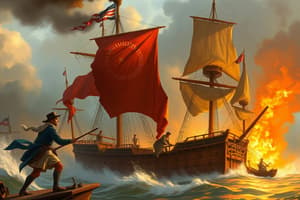Podcast
Questions and Answers
What was the Embargo Act?
What was the Embargo Act?
Passed by the United States Congress; signed by President Thomas Jefferson on December 22, 1807; stopped American ships from trading in foreign ports.
What was the Continental System?
What was the Continental System?
A pair of decrees designed to prohibit the British from trading with the rest of Europe.
What happened in 1805?
What happened in 1805?
Tensions between Britain and France grew.
What happened on June 21, 1807?
What happened on June 21, 1807?
How did America feel about the USS Chesapeake attack?
How did America feel about the USS Chesapeake attack?
When was the Embargo Act introduced?
When was the Embargo Act introduced?
What was the Non-Intercourse Act?
What was the Non-Intercourse Act?
What was Macon's Bill No.2?
What was Macon's Bill No.2?
When was Madison elected president?
When was Madison elected president?
Summarize the Embargo Act.
Summarize the Embargo Act.
Flashcards are hidden until you start studying
Study Notes
The Embargo Act
- The Embargo Act was enacted by the U.S. Congress and signed by President Thomas Jefferson on December 22, 1807.
- The act halted American commerce with foreign ports, aiming to protect U.S. interests against European conflicts, particularly between Britain and France.
- In 1806, France enacted a law that restricted trade with the U.S. and Britain, contributing to rising tensions.
The Continental System
- The Continental System comprised decrees that aimed to block British trade with Europe.
- It threatened to seize neutral ships trading with Britain, intensifying maritime conflict.
Tensions in 1805
- Significant tensions escalated between Britain and France in 1805, impacting international trade relations and maritime security.
USS Chesapeake Incident
- On June 21, 1807, British warships attacked the USS Chesapeake, resulting in three U.S. deaths and eighteen captives.
- Britain justified the attack on claims of retrieving deserters from the Royal Navy, fueling U.S. anger.
American Reaction
- The attack on the USS Chesapeake sparked outrage in the U.S., leading Jefferson to order all British vessels to exit American waters.
Introduction of the Embargo Act
- Senator Samuel Smith introduced the Embargo Act on December 18, 1807, responding to international tension and shipping safety concerns.
Non-Intercourse Act
- Passed on December 22, 1807, the Non-Intercourse Act allowed American merchants to trade with most nations but barred trade specifically with France and Britain.
Macon's Bill No. 2
- Enacted on May 14, 1810, by President James Madison, this bill prompted Napoleon to rescind his trade restrictions against the U.S.
- Madison prohibited trade with Britain when they continued to maintain restrictions on American trade.
James Madison's Presidency
- James Madison was elected president in 1808, taking office during a time of considerable international tension and conflict.
Summary of the Embargo Act
- The Embargo Act was a response to ongoing violations of U.S. neutrality during the Napoleonic Wars.
- Its effects diminished over time, ultimately leading to the implementation of the Non-Intercourse Act and Macon's Bill No. 2, which shifted American trade policy.
Studying That Suits You
Use AI to generate personalized quizzes and flashcards to suit your learning preferences.




